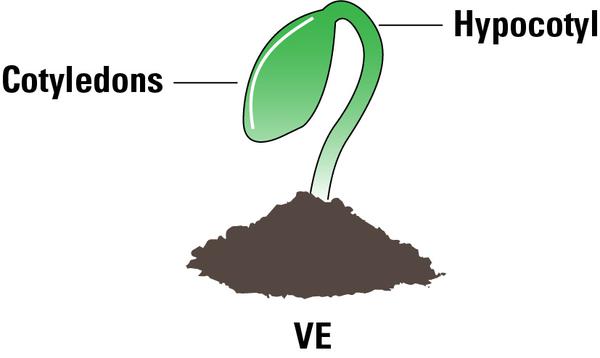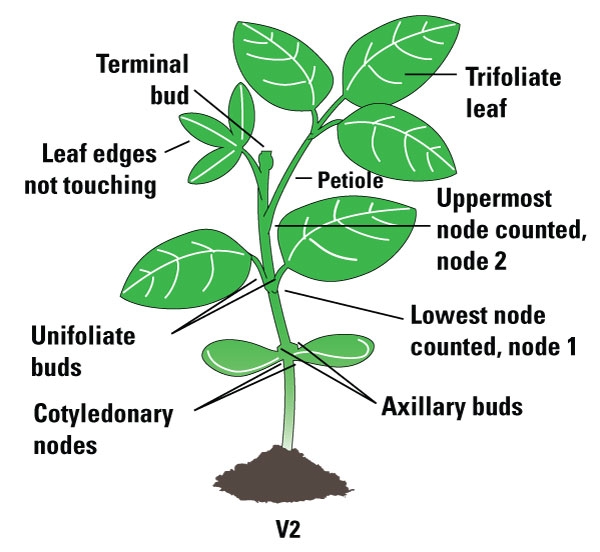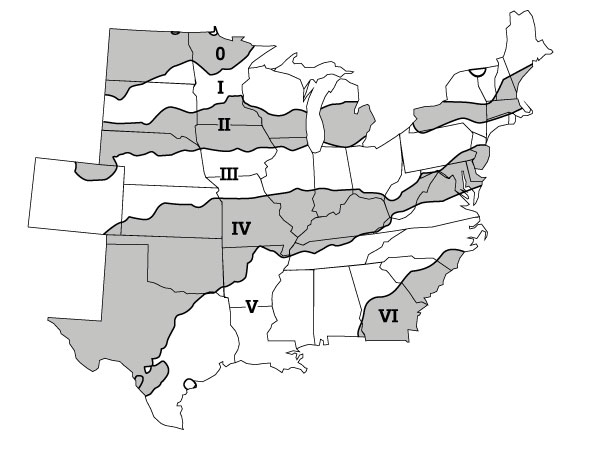Soybean (Glycine max) is native to East Asia and has been grown for thousands of years. The plant has the ability to produce 600 pods per plant, but on average there are 50 to 100 pods per plant that set seed. Each pod contains on average three seeds. The soybean yield components are the number of plants per acre, the number of pods per plant, the number of seeds per pod, and the size of the seed.
Soybean varieties are classified based on their requirement to initiate reproductive development and their morphological growth habit. Soybeans are photoperiod-sensitive, short-day plants, meaning that days must be shorter than a critical value to induce flowering. Soybean varieties are classified into maturity groups (MGs) according to their response to photoperiod. Soybean varieties are also classified based on their growth habit. In varieties with a determinate growth habit, the onset of reproductive growth results in the termination of vegetative growth on the main stem. Indeterminate varieties, however, start flowering several weeks before they terminate vegetative growth.
Soybeans are legumes and, like most other legumes, have the ability to supply their own nitrogen through nitrogen fixation. Nitrogen fixation begins with the formation of a nodule on the root. Nodules are produced from Bradyrhizobium bacteria in the soil that invade the root and multiply within the root cells. The soybean plant supplies the bacteria with nutrients and energy and, in return, the bacteria convert atmospheric nitrogen (N2) in the air to nitrates (N03-) the plant can then use.
Understanding how soybeans grow and develop is critical to effectively managing the crop for increasing yields.
Soybean Growth Stages
A descriptive system has been developed to describe the growth stage of a soybean plant. The system most commonly used was developed by W.R. Fehr and C.E. Caviness in 1977. Understanding soybean growth stages is useful when discussing proper management throughout the year. Soybean development can be divided into vegetative (V) and reproductive (R) stages (Table 1-1). Each stage starts when at least 50% of plants in that field are at that stage, and the stages correlate to development along the main stem of the plant.
The vegetative stages begin with emergence (VE), which occurs when elongation of the hypocotyl brings the cotyledons out of the soil. After emergence, a pair of unifoliate leaves on the first node unroll just above the cotyledons and start the VC stage. Following VC, trifoliate leaves begin to unfold. The number of nodes with the trifoliate leaf fully developed and unrolled is referred to as V(n). A leaf is considered fully developed when the leaf at the node directly above it has expanded enough that the edges of the leaflets are not touching. The vegetative stages proceed from V1 through V(n).
The reproductive stages begin when the first flower is present on the plant (R1). The first flower is typically toward the bottom of the plant. As the plant moves into full bloom, it enters stage R2. The reproductive stages include pod development (R3 and R4), seed development (R5 and R6), and finally maturity (R7 and R8).
| Stage | Stage No. | Abbreviated Stage Title | Description | Image |
|---|---|---|---|---|
| Vegetative Stages |
VE |
Emergence | Cotyledons above the soil surface. | VE growth stage |
|
VC |
Cotyledon | Unifoliate leaves unrolled sufficiently such that the leaf edges are not touching. | VC growth stage | |
|
V1 |
First-node | Fully developed leaves at unifoliate nodes. | V1 growth stage | |
|
V2 |
Second-node | Fully developed trifoliate leaf at node above the unifoliate nodes. | V2 growth stage | |
|
V(n) |
nth-node | ‘n’ number of nodes on the main stem with fully developed leaves beginning with the unifoliate nodes. ‘n’ can be any number beginning with 1 for V1, first-node stage. | V(n) growth stage | |
| Reproductive Stages |
R1 |
Beginning bloom | One open flower at any node on the main stem. | R1 growth stage |
|
R2 |
Full bloom | Open flower at one of the two uppermost nodes on the main stem with a fully developed leaf. | R2 growth stage | |
|
R3 |
Beginning pod | Pod 5 mm (3/16”) long at one of the four uppermost nodes on the main stem with a fully developed leaf. | R3 growth stage | |
|
R4 |
Full pod | Pod 2 cm (3/4”) long at one of the four uppermost nodes on the main stem with a fully developed leaf. | R4 growth stage | |
|
R5 |
Beginning seed | Seed 3 mm (1/8”) long in a pod at one of the four uppermost nodes on the main stem with a fully developed leaf. | R5 growth stage | |
|
R6 |
Full seed | Pod containing a green seed that fills the pod cavity at one of the four uppermost nodes on the main stem with a fully developed leaf. | R6 growth stage | |
|
R7 |
Beginning maturity | One normal pod on the main stem has reached its mature pod color. | R7 growth stage | |
|
R8 |
Full maturity | 95% of the pods that have reached their mature pod color. 5 to 10 days of drying weather are required after R8 before the soybeans have less than 15% moisture. | R8 growth stage |
The descriptions focus on the top of the soybean plant, so they are applicable to both determinate and indeterminate varieties. Some of the stage descriptions may seem awkward, but they were intentionally chosen so they would be interpreted the same by most, if not all, users. The most ambiguous of these stages is R7, which was originally intended to identify physiological maturity. While physiological maturity (when dry matter accumulation ceases) is fairly easy to determine in other crops, identification is more difficult in soybeans. There is no obvious visible signal that indicates physiological maturity has been reached, but Fehr and Caviness’s description applies fairly well to determinate varieties in the South.
The number of days between stages varies depending on the MG and variety planted, but the following trends usually hold true.
-
For any planting date, it takes about 10 days longer to reach R1 as you move up in MGs.
-
The time required for each of the reproductive (R) stages to occur is fairly consistent, regardless of MG.
-
As you delay planting date, the time to reach R1 decreases for all MGs.
Soybean development is also influenced by temperature, day length, soil moisture, and other environmental conditions; therefore, the timing of growth stages will be different for different varieties, planting dates, and climates.
Maturity Groups
Soybeans were first classified into maturity groups in the early 1900s. Today there are 13 major groups ranging from MG 000 to MG 10, with lower-numbered MGs representing earlier-maturing varieties. These groupings were based on adaptation within certain latitudes. A variety is classified to a specific MG according to the length of time from planting to maturity. Maturity group belts run east to west in North America. Historically, lower-number MGs were grown in the extreme northern United States and Canada, and the numbers got progressively higher as you moved south to the Gulf Coast states.
The most recent classification of MGs was carried out in 2017 by Mourtzinis and Conley (Figure 1-1) by aggregating MG-specific yield data from variety performance trials across the United States. Data were collected from 27 states over a period of 14 years to develop the MG zones.
Figure 1-1 shows that most of North Carolina is in the group 5 zone. This implies that a group 5 variety would be considered a mid-season variety for most of the state. A group 4 variety would be considered an early-season variety, and a group 7 variety would be considered a late-season variety. Most of the state could grow all of these MGs successfully.
Because of soybean’s ability to adapt to a wide range of conditions and North Carolina’s flexibility in planting dates, varieties with MG designations outside of the optimal range can still be grown here. North Carolina growers successfully plant a range of MGs, from late 3s to early 8s.
Typically, varieties in earlier-maturing groups develop fewer leaves and reach R1 earlier. This means a group 5 will mature and quit growing earlier than a group 6 will, if planted at the same time. Historically, group 4 and earlier-maturing varieties are indeterminate in growth habit, while group 5 and later-maturing varieties are determinate varieties; but recently, later-maturing indeterminate varieties have been released. Whether one growth habit is an advantage or a disadvantage, compared to the other, is still under investigation. Recent trials in North Carolina—when comparing the two group habits within the same relative MG—have often shown minimal differences in soybean yield. There might be circumstances, such as when the plant is under a lot of stress, in which an indeterminate growth habit would be optimal because it prolongs reproductive development, but this needs to be investigated further in our environment.
Each major MG is further divided 10 times to designate the relative maturity rating for a soybean variety. The relative maturity is expressed as a decimal. For example, a 4.1 will mature earlier than a 4.7, even though they are in the same major MG. Most seed companies use the relative-maturity rating to classify their varieties.
Publication date: July 31, 2025
AG-835
Other Publications in North Carolina Soybean Production Guide
- 1. The Soybean Plant
- 2. Variety Selection
- 3. Fertilization and Nutrient Management
- 4. Soil Health, Tillage, Cover Crops, and Crop Rotation
- 5. Planting Decisions
- 6. Weed Management
- 7. Soybean Diseases and Management
- 8. Soybean Nematode Management
- 9. Insect Management
- 10. Water Management in Soybeans
- 11. Late-Season Management, Harvesting, Drying, and Storage
- 12. Soybean Marketing in North Carolina
Recommendations for the use of agricultural chemicals are included in this publication as a convenience to the reader. The use of brand names and any mention or listing of commercial products or services in this publication does not imply endorsement by NC State University or N.C. A&T State University nor discrimination against similar products or services not mentioned. Individuals who use agricultural chemicals are responsible for ensuring that the intended use complies with current regulations and conforms to the product label. Be sure to obtain current information about usage regulations and examine a current product label before applying any chemical. For assistance, contact your local N.C. Cooperative Extension county center.
N.C. Cooperative Extension prohibits discrimination and harassment regardless of age, color, disability, family and marital status, gender identity, national origin, political beliefs, race, religion, sex (including pregnancy), sexual orientation and veteran status.













